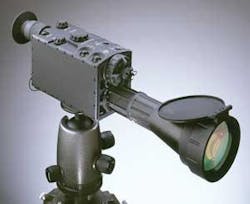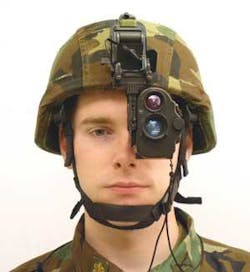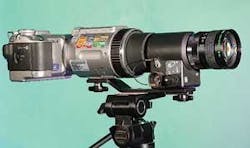No need to be. Night-vision technology has given the U.S. military a tactical edge on the battlefield, enabling them to perform the most sensitive missions night or day from the land or air.
By John McHale
For thousands of years armies were wary of attacking at night. They could make use of artificial light - whether torches, searchlights, or headlights - but illumination always risked revealing maneuvers.
Times have changed. A commander during the first Persian Gulf War of 1991 said the main difference in that conflict was the ability of the U.S. soldier to attack at night, says Jim Ratches, chief scientist at the U.S. Army Night Vision and Electronic Sensors Directorate (NVESD) at Fort Belvoir, Va.
If one pays close attention to newscasts today, soldiers operating in Iraq are performing mostly mundane tasks such as security during the day, while preferring to attack at night, Ratches adds.
Ratches and the engineers and scientists at NVESD have discovered ways to capture available electromagnetic radiation outside that portion of the spectrum visible to the human eye, and have developed equipment to enable the American soldier to fight as well at night as he can during the day, NVESD officials say.
Night-vision technology
The two existing types of night-vision technologies are image intensifiers and thermal imagers.
Image intensifiers capture ambient light and amplify it thousands of times by electronic means to display the battlefield to a soldier via a phosphor display such as night-vision goggles, according to NVESD officials. This ambient light comes from the stars, moon, or sky glow from distant manmade sources such as cities.
The main advantages of image intensifiers as night-vision devices are their small sizes, light weight, low power requirements, and low cost, NVESD officials say. NVESD researchers are working on image intensifiers with longer-wavelength spectral response, higher sensitivity, larger fields of view, and increased resolution relative to existing image intensifiers, as well as with advanced displays and image fusion.
Most objects in natural scenes, as well as human beings and man-made objects, emit electromagnetic radiation in the form of heat. Thermal imagers or forward-looking infrared (FLIR) viewers gather the infrared radiation and form an electronic image for the soldier. Thermal imagers do not rely on reflected ambient light, and have significant penetration capabilities through obscurants such as fog, haze, and battlefield smoke.
Thermal imagers come in cooled and uncooled varieties. Cooled thermal imaging requires cryogenic cooling. Uncooled thermal imagers, which are not so sensitive as cooled devices, require no detector cooling but are sufficient for individual soldier sights, infantry vehicles, navigation, robotics, and missile seekers, NVESD officials say.
NVESDS scientists who specialize in cooled thermal imaging are pursuing multispectral imaging, improved sensitivity and resolution, and embedded signal processing to aid the soldier in target acquisition. Current uncooled research aims at small packages, power consumption, affordable costs, increased sensitivity, sharp resolution, and wide field of view, NVESD officials say. Small, palm-size uncooled thermal imagers have recently become available.
“The major technology issue facing infrared designers today is how to get the system performance of a cooled IR sensor into an uncooled sensor,” says John Hodge, ground systems sales manager for FLIR systems in Billerica, Mass. “Users want the long range and high resolution afforded by cooled systems, but not the maintenance issues associated with them.”
Uncooled imagers are less expensive and come in smaller packages than thermal imagers; they do not need a cooling device, yet are not as efficient as cooled devices. They are prevalent in applications, however, where cooled devices are not necessary, such as man-portable operations.
Image fusion
Image fusion seeks to blend crucial imaging data from image intensifiers and thermal imagers. One aim of image fusion is to integrate the image a soldier gets from his night-vision goggles with one generated from an uncooled thermal imager on his helmet.
Fusing the image would help the solider perform maneuvers at night in hostile terrain such as a dense forest, Ratches says.
The Digital Fusion Goggle (DFG) is a dual-band, helmet-mounted device that provides enhanced vision in environments that are completely dark and/or high in obscurants by fusing image intensification (I2) and long-wave infrared thermal imagery, NVESD officials say. The Digital Fusion Goggles display maps in color. The system has as much as four hours of continuous operation per battery set and uses PVS-7 mounting hardware. The DFG provides a clear operational advantage in caves and buildings.
The technology is still in development and there are different methods being studied on how to overlay the two images, Ratches says.
MERCAT
One of the research projects NVESD scientists are working on is taking the mercury cadmium terranium (MERCAT) material used for uncooled devices and putting it on silicon. MERCAT is “a material God never meant to exist” but one that is necessary for high-performance thermal imaging, Ratches says. It must be cooled at 77 degrees Kelvin.
The problem revolves around its need to be grown on exotic material; placing it on silicon would solve some of the current manufacturing difficulties associated with uncooled imagers and potentially lower the cost.
It will take a few more years before the technology is developed enough to be transferred to a program office, which handles the fielding of technology for the warfighter. NVESD experts research and develop technology but do not field it.
Currently second-generation uncooled thermal imagers are being retrofitted into the Army’s main battle tanks and Bradley Fighting Vehicles, Ratches says. They can detect small thermal differences depict these differences in high resolution, which translates into long ranges for the warfighter, Ratches explains.
Automatic target recognition
Another project NVESD scientists are working on is Aided/Automatic Target Recognition (ATR) capability - a computer processor for the sensor that automatically identifies targets for the soldier, Ratches says. The processor will put a box around different images such as a car, enemy tank, and so on, and identify the image for the soldier. However, it is an aid and not autonomous, he adds. The decision to fire the weapon still lies with the warfighter, Ratches says.
Hardware and software algorithms are being developed to enable ATR systems to automatically acquire, track, recognize, and identify threat targets, NVESD officials say. When these functions are performed by the signal processing in a night-vision system, such as a thermal imager, the soldier’s workload is reduced and his accuracy increases resulting in increased survivability and lethality. The ATR is still in research and development.
The Army is also looking at developing small thermal systems for unmanned aerial vehicles; Army UAVs are much smaller than the Air Force’s Global Hawk, and often weigh less than 100 pounds, Ratches says.
While NVESD develops many of the technologies for night-vision capability, the equipment comes from companies such as FLIR, B.E. Meyers, ITT Industries Night Vision, and BAE Systems.
FLIR
FLIR offers night-vision equipment for airborne and ground applications.
FLIR’s Hodge sees three current trends in the night-vision market: autonomous sensors as part of an integrated package, rugged systems for rugged environments (Iraq and Afghanistan), and multisensor platforms that have more than just infrared.
FLIR’s lightweight, triple-payload Ultra 8500 is designed to meet the multiple-role mission requirements of airborne law enforcement by offering increased standoff capabilities, infrared imaging performance, and auto-tracking for improved surveillance capabilities.
The continuous-zoom 320-by-240-pixel indium antimonide (InSb) infrared imager and 18×/72×, 0.2 lux low-light TV camera can be combined with an optional Class III3b continuous-wave diode laser. Ground forces equipped with night-vision goggles can see the 30-milliwatt laser beam and spot, though it remains invisible to the suspect, FLIR officials say. New on-screen graphics promote rapid in-flight decision-making.
A FLIR ground product is the rugged SeeSPOT III (AN/PAS-21) for stand-alone operations or with a 1.06-micron laser target designator. Providing four times the thermal sensitivity of uncooled IR viewers, the SS3 delivers detailed long-range thermal imagery in most climatic conditions, day and night, FLIR officials say.
“Next-generation technology will incorporate the multisensor mentioned before as well as units that fuse images from IRE and other sensors such as I2 or near IR,” Hodges says. For more on FLIR go to www.flir.com.
BE Meyers
Engineers at B.E. Meyers in Redmond, Wash., offer the Ultraowl pocket-scope. It has a built-in illuminator and a wide range of high-performance adapters available for digital, film, video, CCD cameras, weapons, and magnification lenses. Thousands of the previous-generation Superowl units are used with covert surveillance teams, company officials say.
The majority of B.E. Meyers customers for night-vision are looking for custom designs that they cannot get anywhere else, says Brad Meyers, president of B.E. Meyers.
Another product is the MOUT Tracker, which is a camera used for urban warfare training that illuminates a room but is not visible to night-vision equipment, Meyers says. For more on B.E. Meyers go online at www.bemeyers.com.
ITT
Officials at ITT Industries Night Vision in Roanoke Va., will provide submersible AN/PVS-14 Monocular Night-Vision Goggles (NVGs) and associated line items to Naval Special Warfare personnel.
NVGs enhance situational awareness and improve visibility in less than optimal viewing conditions. Specifically, the Navy uses the goggles for shipboard security, precision weapons firing, navigation, and small-boat tactics, ITT officials say. The Naval Surface Warfare Center Crane Division in Crane, Ind., is the contracting activity. Work will be finished by September 2009.
In October leaders of the U.S. Air Force awarded a $40 million contract for AN/AVS-9 night-vision goggles. Air crews will wear the goggles to fly aboard H-60 helicopters, KC-135 and KC-10 tankers, and C-17 and C-130 transport aircraft.
Infrared imaging and image intensification each has weaknesses - the visible light viewer cannot see through smoke or fog, while the infrared viewer cannot see through glass. Now U.S. Army leaders want to combine the two methods into one unit, which they have dubbed the enhanced night-vision goggle (ENVG).
ITT Night Vision is bidding for a contract to supply the new unit; the company won a 2003 research contract to supply 75 ENVG systems toArmy testers, and has continued to make improvements.
Their prototype uses two sensors - a far-infrared sensor from Raytheon Network Centric Systems in Plano, Texas, and a visible and near-infrared sensor from ITT, says Jim Harris, vice president and director of engineering for ITT Industries Night Vision.
ITT engineers overlay the images with a beam combiner, so a soldier looking through the device has a direct view to his target as if he were gazing through binoculars.
For more on ITT go online at www.itt.com.
BAE Systems
Officials at BAE Systems in Lexington, Mass., announced that they were awarded a second-year production contract for the Thermal Weapon Sight II (TWS II) by the U. S. Army’s Communication and Electronics Command (CECOM) at Fort Monmouth, N.J. CECOM officials are calling for 4,028 weapon sites with options for an additional 2,500 sites. This $33 million PY-2 production contract raises the total contract value to $53 million.
BAE Systems experts are developing and qualifying the TWS II in partnership with Program Executive Office (PEO) Soldier at Fort Belvoir, Va., to provide the Army infantry and U.S. Marine Corps with the ability to detect and engage targets day or night, in all weather and battlefield obscurant conditions. The TWS II enables individual and crew-served weapon gunners to see deep into the battlefield, increasing their surveillance and target-acquisition range.
The TWS II weapons sites will be produced at BAE Systems’ IR imaging systems facility in Lexington, Mass.
BAE Systems’ TWS family of sights, produced under this contract, complement current and future infantry armament - from light to medium and heavy weapons. The light-weapon thermal sight weighs less than two pounds and mounts primarily to M4 carbines and M16 rifles. The medium- and heavy-weapon thermal sights weigh less than three and four pounds, respectively. The latter provide airborne, air assault, Ranger, and mechanized infantry forces with long-range target detection to engage their crew-served armaments.
All three TWS variants use MicroIR microbolometer sensor-engine technology from BAE Systems. Similar MicroIR technology is also being used in cameras serving homeland security customers in public safety, industrial, and security sectors.
For more information, go to www.baesystems.com.
ITT builds night-vision pocket-scopes for FBI
Officials at ITT Industries Night Vision (ITT) in Roanoke, Va., won an order from the Federal Bureau of Investigation (FBI) in Washington to supply night-vision pocket-scopes for use in low-light surveillance activity.
“In our current environment, the need for timely and accurate intelligence is more critical than ever,” says Gary Hopkins, contracting officer for the FBI. “Night-vision technology allows us to conduct our missions 24 hours a day, it’s a must have for the FBI.”
ITT’s NE 6010F pocket-scope is a small, lightweight image intensifier that can be hand-held as a monocular or camera-mounted as a night-vision lens. Its adaptability to video and still-action cameras aids evidence gathering in the dark.
During the past several years, ITT has supplied the FBI with ground and aviation night-vision goggles, similar to what it provides Department of Defense (DOD) military forces. Since Sept. 11, 2001, the need for night-vision technology has increased with Federal and state/local law enforcement agencies’ increased homeland security responsibilities. For more information, see www.itt.com.
Lockheed Martin adds night-vision goggles to Air Force F-16 simulators
Engineers at Lockheed Martin in Akron, Ohio, demonstrated a night-vision goggle (NVG) capability for U.S. Air Force F-16 jet fighter simulators to enable pilots to train more realistically.
“Current combat missions require pilots to use NVG and master that skill in order to ensure their decisive advantage,” says Jerry Keehner, Lockheed Martin program director of simulation and training. “The NVG training capability provides pilots night sensory and visual cue training, which is crucial for mission preparedness and flight safety.”
In training, pilots will wear goggles fitted with a night-vision display channel correlated with the cockpit visual scene. Controlled by helmet-mounted sensors, the NVG allows pilots to see the appropriate night-vision database in every direction. Working under a $3.7 million Air Force development contract, Lockheed Martin teamed with MultiGen-Paradigm, Inc., and Silicon Graphics, Inc. to create the hardware and sensor system package.
“Because of the unique tool set our team developed, we are able to successfully integrate the night-vision database with the high-fidelity out the window visual database,” says Jeff Prulhiere, Lockheed Martin F-16 Mission Training Center (MTC) program manager.
“In the aircraft, pilots can see below their goggles to gain aspect cues so we incorporated that realism into the training. We also improved the head tracking concept by using ultrasonic sensors in the cockpit to instantly track the pilots head movements and therefore increase responsiveness in the NVG system.”
Two four-cockpit-simulator MTCs are supporting training at Shaw Air Force Base, S.C., and Spangdahlem Air Base, Germany. A two-cockpit MTC is operational at Mountain Home Air Force Base, Idaho. A four-cockpit MTC will be delivered to Misawa Air Base, Japan, in 2005.
The F-16 MTC delivers immersive training with realistic visual cues and real-time correlation between the high-resolution 360-degree visual system and the high-fidelity simulation of aircraft performance. F-16 MTCs will be capable of long-haul network operations tied with other Air Force simulation assets over a long-haul network, Lockheed Martin officials say.
Quantum3D develops simulated night vision
Experts at Quantum3D in San Jose, Calif., are developing simulated night-vision capability for fixed-wing and helicopter simulators.
There are two kinds of infrared for simulated training purposes - stimulated and simulated, says Mike Raines, vice president of business development at Quantum3D.
Stimulated is when actual night-vision goggles are used during a simulation exercise, and simulated is when the graphics and display create night-vision imagery.
Some military personnel prefer stimulated because they use actual goggles but from a performance standpoint it is more efficient to use stimulated, Raines says.
For a computer and display to create an actual night-vision display it would need to generate a tremendous amount of light to match real-time conditions, he says. Plus the pilot is continually looking out his goggles for naked eye out of window views.
Quantum3D’s simulated product is called Quest and works with simulator helmet mounted displays (HMDs) made by many different companies such as Rockwell Collins.
Pilots go into a night-vision-goggle training scenario by putting the HMD on and a fast switch over occurs to night-vision views, Raines says. Much greater detail is possible with simulated night vision because of the graphic capabilities of the computer and software, he adds.
The Joint Strike Fighter Lab is currently using Quest, Raines says.
For more information go online at www.quantum3d.com.
Gulfstream to install infrared sensors from Elbit Systems
Officials at Elbit Systems Ltd. in Haifa, Israel, announced that their U.S. subsidiary won a $20 million contract to supply Enhanced Vision Systems (EVS) to Gulfstream for all large-cabin aircraft.
The EVS will be installed aboard the Gulfstream G450 and ultra-long-range G550 as production standard items. The system will also be available as optional equipment on the Gulfstream G300, G350, G400, and G500, Elbit officials say.
All Weather Window EVS employs an advanced infrared sensor that presents an image projected on any raster-video-capable head-up display and head-down display, providing the pilot with a forward-looking picture overlaying the outside view in a conformal manner. The system enables the pilot to clearly view lights and ground features (such as runways, terrain, aircraft, and buildings) at night and in low visibility conditions.
The EVS has few training requirements and no database or infrastructure requirements, Elbit officials say. The pilots and their passengers immediately benefit from lower landing minima, improved flight safety, and increased situational awareness, company officials say.
The EVS has secured firm orders from different customers for more than 700 systems, serving 12 models of aircraft covering each of the top aircraft manufacturers in the airline and business jet industry. For more information see www.elbitsystems.com.




